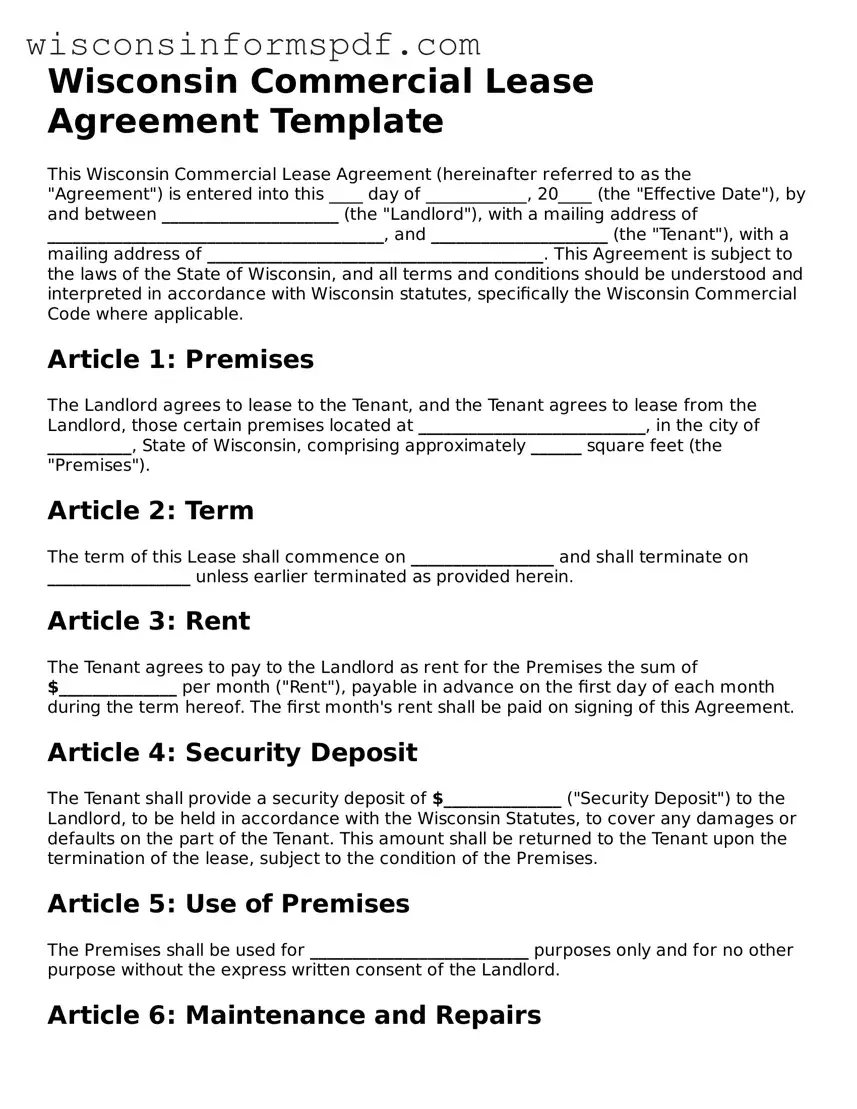Wisconsin Commercial Lease Agreement Template
This Wisconsin Commercial Lease Agreement (hereinafter referred to as the "Agreement") is entered into this ____ day of ____________, 20____ (the "Effective Date"), by and between _____________________ (the "Landlord"), with a mailing address of ________________________________________, and _____________________ (the "Tenant"), with a mailing address of ________________________________________. This Agreement is subject to the laws of the State of Wisconsin, and all terms and conditions should be understood and interpreted in accordance with Wisconsin statutes, specifically the Wisconsin Commercial Code where applicable.
Article 1: Premises
The Landlord agrees to lease to the Tenant, and the Tenant agrees to lease from the Landlord, those certain premises located at ___________________________, in the city of __________, State of Wisconsin, comprising approximately ______ square feet (the "Premises").
Article 2: Term
The term of this Lease shall commence on _________________ and shall terminate on _________________ unless earlier terminated as provided herein.
Article 3: Rent
The Tenant agrees to pay to the Landlord as rent for the Premises the sum of $______________ per month ("Rent"), payable in advance on the first day of each month during the term hereof. The first month's rent shall be paid on signing of this Agreement.
Article 4: Security Deposit
The Tenant shall provide a security deposit of $______________ ("Security Deposit") to the Landlord, to be held in accordance with the Wisconsin Statutes, to cover any damages or defaults on the part of the Tenant. This amount shall be returned to the Tenant upon the termination of the lease, subject to the condition of the Premises.
Article 5: Use of Premises
The Premises shall be used for __________________________ purposes only and for no other purpose without the express written consent of the Landlord.
Article 6: Maintenance and Repairs
The Tenant agrees to maintain the Premises in good and safe condition, including making necessary repairs and replacements, except for normal wear and tear, and except for repairs and maintenance required to be made by the Landlord under this Agreement or by law.
Article 7: Alterations and Improvements
Tenant is prohibited from making any alterations, additions, or improvements to the Premises without the prior written consent of the Landlord. Any authorized alterations, additions, or improvements will become the property of the Landlord upon termination of this lease.
Article 8: Insurance
The Tenant agrees to maintain at its own expense, a comprehensive general liability insurance policy covering the Leased Premises against claims for personal injury, death, or property damage, with the Landlord named as an additional insured party.
Article 9: Assignment and Subletting
The Tenant shall not assign this lease or sublet the Premises without the prior written consent of the Landlord, which consent shall not be unreasonably withheld.
Article 10: Default and Termination
In the event of a default by the Tenant under the terms of this Agreement, the Landlord may terminate this lease in accordance with Wisconsin law, and pursue other remedies available under the law.
Signatures
IN WITNESS WHEREOF, the parties hereto have executed this Wisconsin Commercial Lease Agreement as of the Effective Date first above written.
Landlord's Signature: ____________________________________ Date: _______________
Tenant's Signature: _____________________________________ Date: _______________
